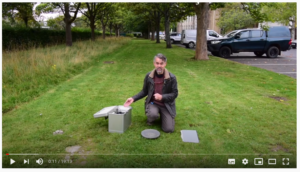The teaching year at the University of Edinburgh is properly under way now, but what an odd year it is. I have only seen students in the flesh for one brief outdoor class; all the rest of my teaching has been done remotely. For most of the classes it may not be much of a disadvantage to have me on the other end of a video conference call; the real loss is the 4th-year geophysics field trip (see blog posts passim ad nauseam, here, here, here, here and here).
Last year’s trip to the Eifel region of Germany somehow escaped a blog post, but I have had to revisit it this year in order to give the students some sort of exercise as a replacement for actually going on the trip. In doing this, I have learned a great deal about magnetic and electromagnetic surveys, refraction seismic lines, and electrical resistivity tomography sections. For me, though, the exciting thing about that trip was that the gravity survey actually found something. Often, especially on trips to Montalivet-les-Bains, I have spent a week doing gravity and come away with almost no insight into the sub-surface.
[ Feb 2022 edit: I have removed the picture from here as we will be returning to the same site in September 2022: I would hate to spoil the fun for thts year’s class]
Last year’s gravity map, however, showed a clear area of lower gravity (red colours) in the centre of the field area. The area is the site of a fairly recent, and very explosive, volcanic eruption; the gravity low probably locates the centre of the eruption, where a great deal of material was blasted out, and whatever filled up the resulting hole is not so densely packed.
So that the students can at least see how the data were taken, we have provided some videos of geophysics equipment in use. Most of these starred one of our Ph.D students, but I presented the gravity one myself; you can laugh at it here.
(Many thanks are due to Sophie Butcher for filming and editing the video.) Although it is of some use to give the students who missed the field trip an idea of how the data were taken, it is of more use to a small group of third years who are going to do a gravity survey in Edinburgh as their group project. If they all bother to watch the video, they will not have to spend any time huddled round the instrument with me breathing at them while I explain it, or with me touching controls that they are about to touch themselves. So we should be able to do the survey in a socially-distanced manner.


